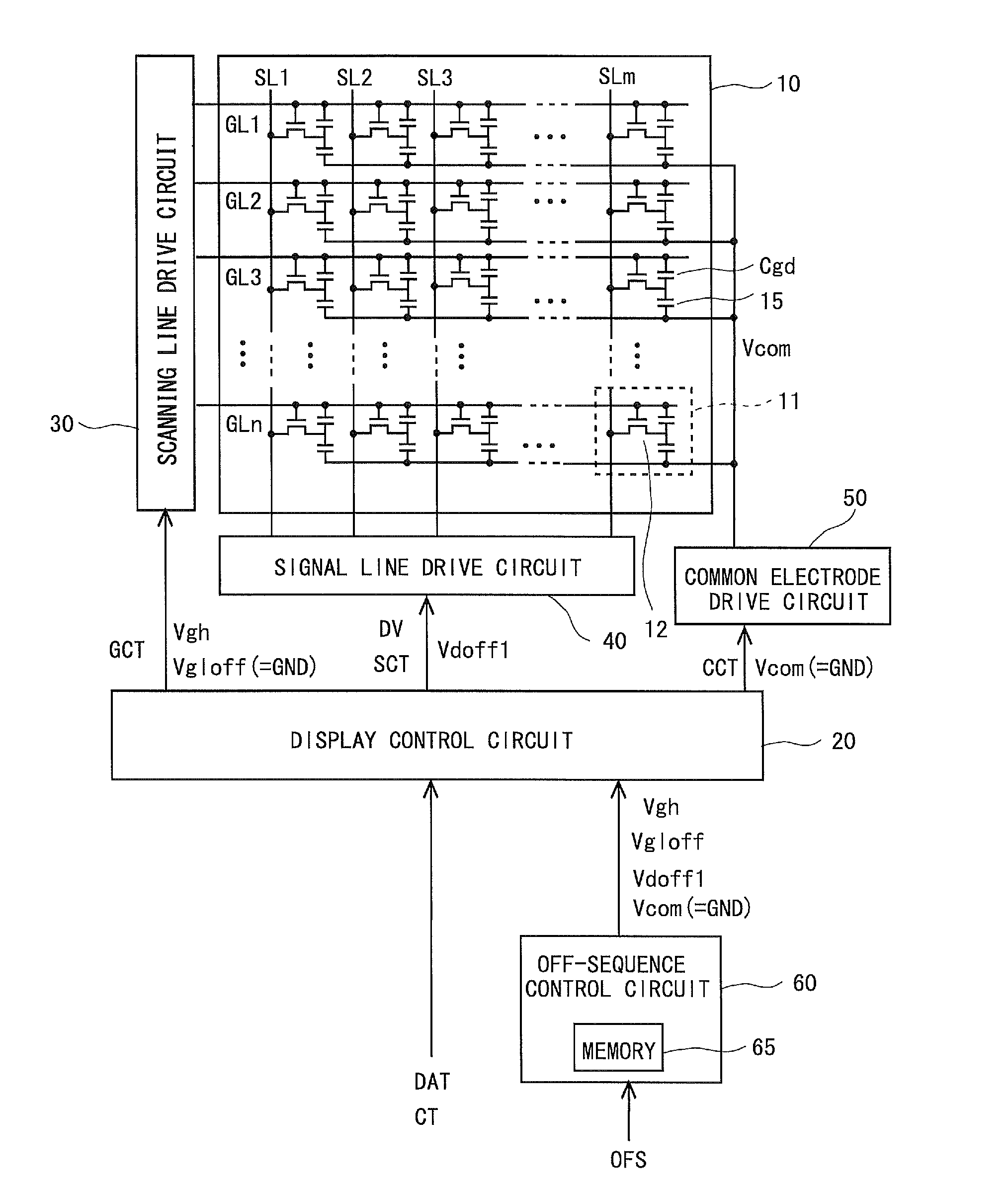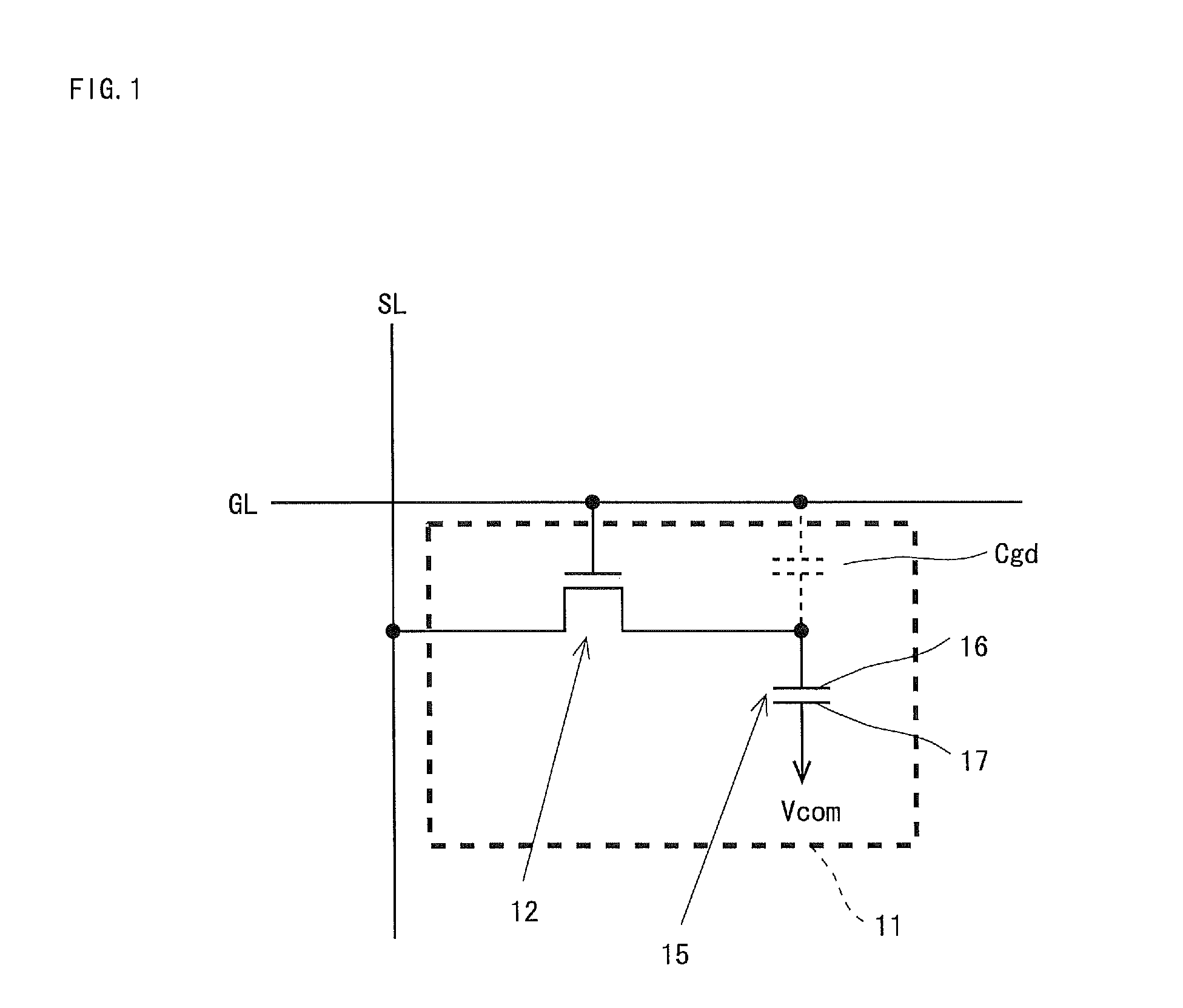Liquid crystal display device and driving method thereof
a technology of liquid crystal display and driving method, which is applied in the direction of electric digital data processing, instruments, computing, etc., can solve the problems of optimum common voltage generation, flickering, and large off-leak current flowing at a time of the off state, and achieve the effect of increasing the amount of electric charges accumulated in the pixel capacitance and reducing the amount of electric charges
- Summary
- Abstract
- Description
- Claims
- Application Information
AI Technical Summary
Benefits of technology
Problems solved by technology
Method used
Image
Examples
first embodiment
2. First Embodiment
[0044]
[0045]FIG. 4 is a block diagram showing a configuration of a liquid crystal display device according to a first embodiment of the present invention. As shown in FIG. 4, the liquid crystal display device includes: a display unit 10; a display control circuit 20; a scanning line drive circuit 30; a signal line drive circuit 40; a common electrode drive circuit 50; and an off-sequence control circuit 60. All of these units are formed on a liquid crystal panel (not shown) composed of an insulating substrate such as a glass substrate.
[0046]On the display unit 10, there are formed: a plurality (m) of signal lines SL1 to SLm; a plurality (n) of scanning lines GL1 to GLn; and a plurality (m×n) of pixel formation portions 11 provided so as to correspond to intersections of the m signal lines SL1 to SLm and the n scanning lines GL1 to GLn. Hereinafter, in a case where the m signal lines SL1 to SLm are not distinguished from one another, these are simply referred to as...
second embodiment
3. Second Embodiment
[0070]
[0071]A configuration of a liquid crystal display device according to a second embodiment is the same as the configuration of the liquid crystal display device according to the first embodiment, and accordingly, a block diagram showing the configuration is omitted. Moreover, among constituent elements included in the liquid crystal display device according to this embodiment, those different from the constituent elements included in the liquid crystal display device according to the first embodiment are mainly described.
[0072]Operations of the respective circuits in the on-sequence mode are the same as those in the case of the first embodiment, and accordingly, a description thereof is omitted, and operations of the respective circuits in the off-sequence mode are described. In a case where the off signal OFS is given to the off-sequence control circuit 60, the off-sequence control circuit 60 reads out a variety of signals prestored in the memory 65, and ou...
third embodiment
4. Third Embodiment
[0088]
[0089]A configuration of a liquid crystal display device according to a third embodiment is the same as the configuration of the liquid crystal display device according to the first embodiment, and accordingly, a block diagram showing that configuration is omitted. Moreover, among constituent elements included in the liquid crystal display device according to this embodiment, those in which functions are different from those of the constituent elements included in the liquid crystal display device according to the first embodiment are mainly described.
[0090]Operations of the respective circuits in the on-sequence mode are the same as those in the case of the first embodiment, and accordingly, a description thereof is omitted, and operations of the respective circuits in the off-sequence mode are described. In a case where the off signal OFS is given to the off-sequence control circuit 60, the off-sequence control circuit 60 reads out a variety of signals pre...
PUM
 Login to View More
Login to View More Abstract
Description
Claims
Application Information
 Login to View More
Login to View More - R&D
- Intellectual Property
- Life Sciences
- Materials
- Tech Scout
- Unparalleled Data Quality
- Higher Quality Content
- 60% Fewer Hallucinations
Browse by: Latest US Patents, China's latest patents, Technical Efficacy Thesaurus, Application Domain, Technology Topic, Popular Technical Reports.
© 2025 PatSnap. All rights reserved.Legal|Privacy policy|Modern Slavery Act Transparency Statement|Sitemap|About US| Contact US: help@patsnap.com



